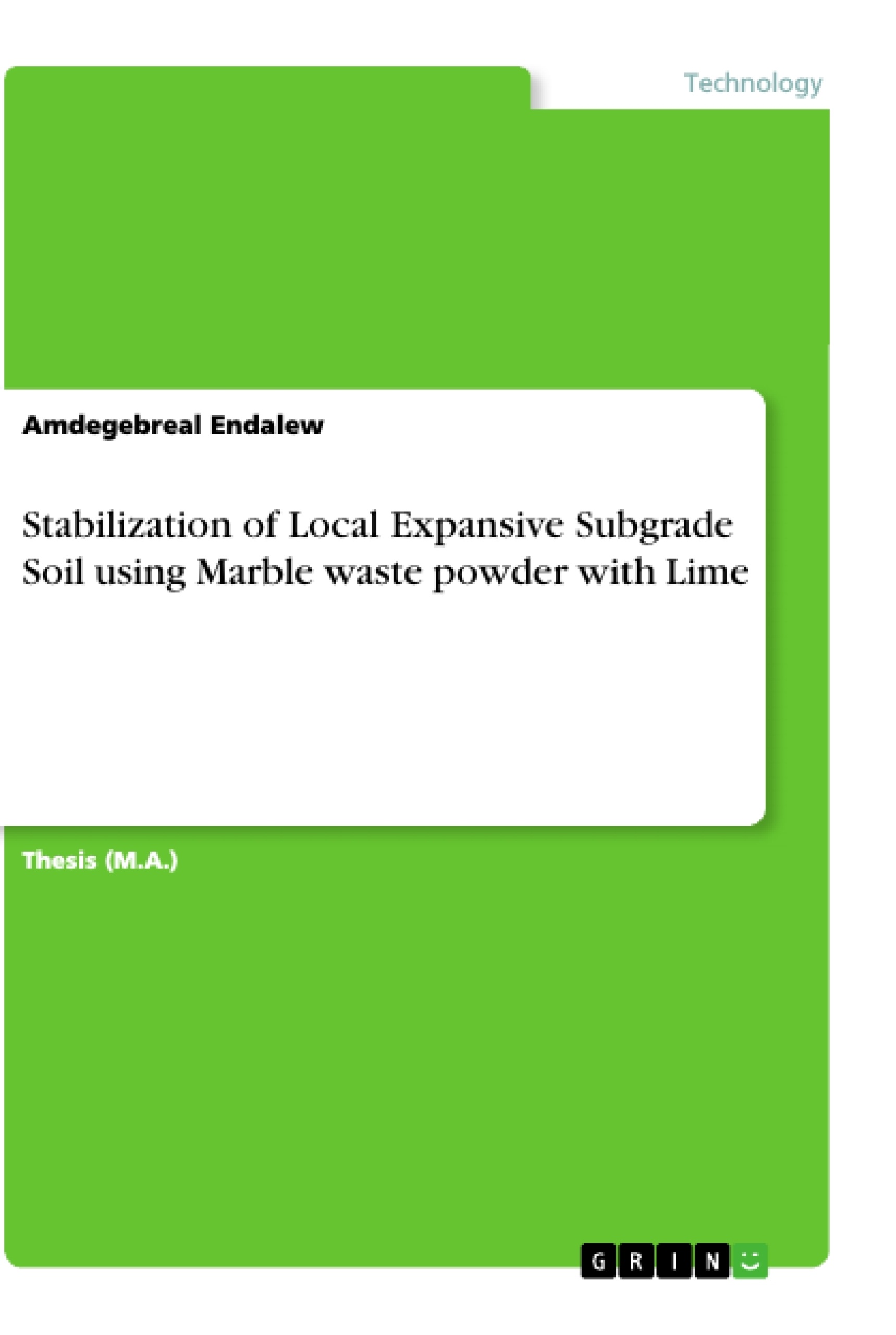Expansive soils are the most problematic soils due to their property of swelling and expansion with the influence of variable moisture, a number of civil engineering structures were destroyed. A billions of US dollars spent worldwide each year to mitigate the problem. The presence of expansive sub-grade soil results pavement distress and damage. Removing the expansive soil and replacing with the competent material is applied to mitigate the problem which is very expensive and time consuming for long hauling distance and thick layer expansive soil. This study presented stabilization of local expansive sub-grade soil using marble waste powder with lime.
The marble waste powder was collected in Addis Ababa from Ethiomarble processing enterprise Gulele branch and the lime was collected at Gast Solar Mechanics in Addis Ababa. Free swell index test, Atterberg limit test, Proctor test, unconfined compressive test, California Bearing Ratio Tests, swelling potential and swelling pressure test were used to evaluate properties of treated and untreated soils. The expansive subgrade soil was treated using 5%, 10%, 15%, 20%, and 25% marble waste powder with fixed 3% lime respective combinations by weight of the soil. The optimum percent combination for this study was 10% marble waste powder with 3%lime based on soaked CBR swell, soaked CBR, swelling pressure and swelling potential test result values. Optimum proportion of stabilizers improve CBR Value from 0.65% to 4.19%, reduce swelling pressure from 1000kpa to 440kpa, increases MDD from 1.21 to 1.29, and reduce PI from 78% to 48.4%. Keywords: marble waste powder, lime, expansive soil, CBR, UCS, swelling pressure, MDD, OMC
Inhaltsverzeichnis (Table of Contents)
- INTRODUCTION
- Background
- Problem statement
- Objective
- Justification
- Scope of the work
- Methodology of the report
- Organization of the report
- LITERATURE REVIEW
- Distribution of expansive soil
- Worldwide distribution of expansive soil
- Distribution of expansive soil in Ethiopia
- Mineralogical composition of expansive soils
- Identification
- Field identification
- Laboratory identification
- Damaging effect of expansive sub-grade soils
- Mitigating the effect of expansive sub-grade soils
- Soil replacement
- Surcharge loading
- Pre-wetting
- Moisture control
- Compaction control
- Grouting
- Mechanical stabilization
- Chemical stabilization
- Distribution of expansive soil
Zielsetzung und Themenschwerpunkte (Objectives and Key Themes)
This thesis investigates the effectiveness of using marble waste powder mixed with lime to stabilize expansive sub-grade soil. The research aims to determine the optimal proportions of these materials to achieve desired geotechnical properties for construction purposes.
- The impact of expansive soil on civil infrastructure
- Stabilization techniques for expansive soils
- The effectiveness of marble waste powder and lime as stabilizers
- The determination of optimal mixing proportions
- The evaluation of the stabilized soil's geotechnical properties
Zusammenfassung der Kapitel (Chapter Summaries)
The introductory chapter establishes the background of expansive soils, outlines the problem statement, and defines the research objectives. It emphasizes the importance of this study in addressing the challenges posed by expansive soils in construction.
The literature review chapter provides a comprehensive overview of the distribution, mineralogical composition, identification methods, and damaging effects of expansive soils. It also explores various mitigation techniques, including soil replacement, surcharge loading, pre-wetting, moisture control, compaction control, grouting, mechanical stabilization, and chemical stabilization.
Schlüsselwörter (Keywords)
Expansive soil, sub-grade soil, stabilization, marble waste powder, lime, geotechnical properties, California Bearing Ratio (CBR), unconfined compressive strength (UCS), optimum moisture content (OMC), maximum dry density (MDD), plasticity index (PI), liquid limit (LL), free swell index (FS).
- Citar trabajo
- Amdegebreal Endalew (Autor), 2016, Stabilization of Local Expansive Subgrade Soil using Marble waste powder with Lime, Múnich, GRIN Verlag, https://www.grin.com/document/520373



